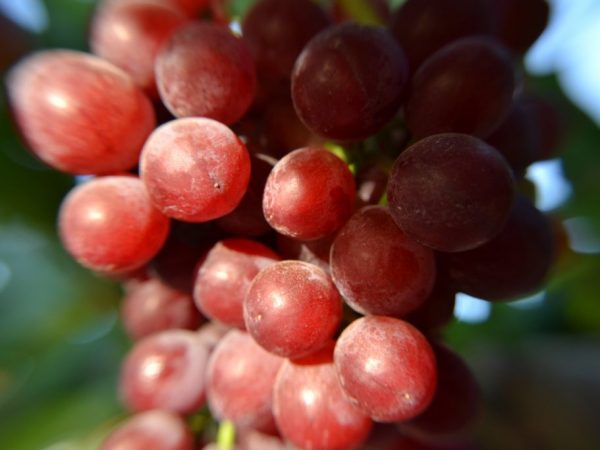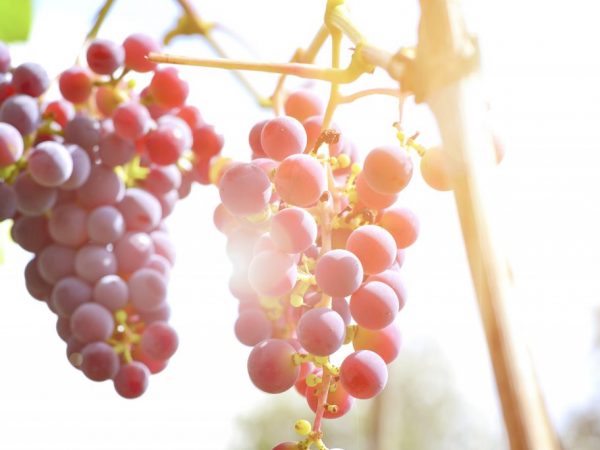Growing Typhoon grapes
Typhoon grapes, brought from Arabia, gained fame many decades ago. It gained its popularity due to its wonderful taste, a set of nutrients and useful microelements. Also, this grape has a low calorie content and is useful for dieting.

Growing Typhoon grapes
Variety characteristic
Typhoon is fast and active. A young seedling will give its first harvest in 2-3 years. Full fruiting will occur in 4-5 years.
Its cuttings adapt to any soil and take root well in it. It belongs to the eastern group in terms of biological and morphological characteristics. According to the description of the mid-season variety in the state register, ripening occurs on the 170th day from the moment the buds open. Average frost resistance.
It has several other names: Ak Taifi, Taifi Safet, Monty. It comes in white and pink. It is used fresh for food and for drying.
Description of the vine
- highly developed bush;
- easy pubescence of shoots;
- the color of the shoots is dark, with a crimson border;
- petiole notch open;
- bristly pubescence of the lower part of the leaf;
- bisexual flower.
According to the description, the shoots are annual, brownish in color. The leaves are characterized by dissection and five-leafing, slightly raised edges. Their shape is rounded-oblong.
The upper notches are closed, ovoid with a lumen, and the lower ones are of medium depth and lyre-shaped.
Description of bunches and berries
This grape has beautiful and tasty berries, which are located on spectacular bunches, with developed lateral blades. According to the description in a bunch of grapes:
- conical or cylindro-conical shape;
- large, weight up to 2.5 kg;
- loose (not a snug berry);
- long stiff leg;
- berry weight up to 9 g;
- berry size up to 30 mm in length;
- the shape of the berries is oval, the top is beveled;
- the color is reddish, with a purple tint.
The berries have a protective whitish waxy coating and a dense skin. Their flesh is fleshy, crispy and dense, red in color. The taste is sweet, with a slight, barely perceptible sourness.
This variety is characterized by late ripening of fruiting shoots.
The main advantages of the variety

Berries tolerate transportation well
Compared to other table varieties, Typhoon has several advantages:
- high survival rate of cuttings in any conditions;
- fruiting in stepsons;
- not whimsical to soil;
- drought-resistant;
- high commodity value;
- good transportability;
- salt-tolerant;
- berries do not fall off the bush.
Features of agricultural technology
This grape belongs to the rosé class and is formed on a tall stem. To achieve high yields, fruit vines are cut into 9-10 eyes.
It is better to plant in warm regions of the country to avoid freezing. In the northern regions, provide adequate shelter for the winter. In the spring, all the covering material is removed before the onset of stable heat, in order to avoid overheating of the root system.To improve ventilation, special holes are made in the root zone.
Landing
Plant Typhoon in the southwest of the site, without a lot of light and heat, preferably near a shelter (fence, walls, etc.).
The vine is planted in early spring in a hole 80 cm deep. It is prepared in advance, its bottom should be fertilized by sprinkling the soil mixture from the earth and organic matter. A seedling is placed on a hill from this soil mixture and sprinkled with earth, compacted and watered with warm water. The abundance of moisture accelerates the survival rate.
If the area where the grapes will grow is blown by drafts, it should be fenced off.
Tafi grape care
All bushes are pruned in the fall. Formation takes place on a high trunk and is watered abundantly with water. The moisture recharge will ensure the health of the vine and protect it from fungal diseases.
Before the onset of cold weather, it is necessary to prepare a reliable shelter for the vine. To do this, it is removed from the trellises, laid on the ground and covered with a film (the material is chosen to be breathable) and sprinkled with cut grass with a small amount of soil.
Diseases and the fight against them

Examine the plant regularly for signs of disease
The most dangerous disease is mildew. The reason for the appearance is high moisture in the soil, high air temperature, excessive nitrogen fertilizers, poorly pruned pruning and untimely tying.
Disease symptoms:
- leaves turn yellow
- plaque appears on the underside of the sheet
- the skin of the fruit shrinks
- shoots turn black
- berries lose sugar content
You need to fight the disease quickly. For this, spraying with maneb or zineb is carried out. To prevent the disease, spring plowing and constant weeding are carried out.
The growth and development of the plant is inhibited by oidium. The whole bush is covered with dust, white bloom. The onset of the disease is provoked by heat, dry air or a sharp change in weather conditions. The second reason is the late removal of the stepsons and untimely tying to the trellis.
The whole aerial part is ill. Typical signs appear on the 6-7th day. If you delay the treatment, then 90% of the crop will be lost. Signs of illness include:
- leaf spots (gray or white)
- plaque all over the bush
- brown marks after touching the affected areas
- leaves dry up
- buds and flowers fall
- the berries are rotting.
To fight, all plants are sprayed with iron vitriol. Before flowering, clusters and sprouts are processed with ground sulfur. For prevention, fertilizing with potassium and phosphorus is carried out.
If you plant a rose bush next to it, it will become an indicator of all sorts of diseases. The rose will fall ill 2 weeks earlier than the grapes and thereby give a signal of impending danger.
The spider mite is able to suck out all the useful juices from the plant. The bush will die if the pest is not destroyed in time. For this, spraying with DNOC, rogor or other sulfuric substances is carried out.
Conclusion
Such a popular and delicious grape variety can be grown not only by an experienced winegrower, but also by a novice amateur. The use of such berries in food will bring undoubted benefits, increase the body's resistance to disease and saturate it with biologically active substances.


